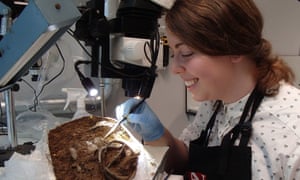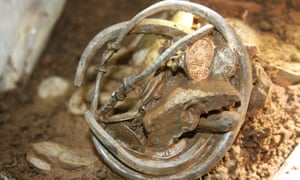Coins and other items buried in the late 870s and found by hobby metal
detectorist in farmer’s field in Oxfordshire may be worth a small fortune
http://www.theguardian.com/science/2015/dec/10/watlington-hoard-viking-silver-coins-alfred-the-great
 Part of the hoard being examined at the British Museum. Photograph: PA
Part of the hoard being examined at the British Museum. Photograph: PA
A hoard of Viking silver that casts new light on Alfred the Great and the one-time ally he virtually obliterated from history has been found by a metal detectorist in a field in Oxfordshire.
The hoard, described when it arrived at the British Museum as “a greasy haggis with bits of treasure sticking out at the corners”, was buried in the late 870s, the period in which the hit television series Last Kingdom is set. It may have been the hastily concealed wealth of a Viking conscious of imminent regime change after the defeat of the invaders by Alfred the Great at the battle of Edington in 878.
The discovery in October, on farmland near Watlington, may be worth a small fortune to the retired advertising executive who helped excavate it on his 60th birthday, and to the farmer who owns the land. As well as a scrap of chopped up gold – the first found in a Viking hoard in Britain – silver arm rings and ingots, it includes at least 180 silver coins, some fragmentary but many well preserved. Alfred the Great silver coins are commercially valued at more than £2,500 each, and far more for particularly rare ones in good condition.
“My children haven’t always been particularly interested in what Dad does,” said the finder, Jim Mather, “but they’re impressed now.”
The coins show an emperor’s head on one side and two emperors seated side by side on the other. They were jointly issued by King Alfred the Great of Wessex and King Ceolwulf II of Mercia when they were allies despite the traditional rivalry of their kingdoms.
Alfred the cake burner and Viking beater is one of the most famous kings in British history, but poor Ceolwulf is only known from a list that says he reigned for five years. His fate is unknown, and the only accounts of his character come from Alfred’s side – after the victorious Alfred also annexed Mercia – describing him as foolish and a puppet of the Vikings.
The newly found coins cover several years and were struck in different mints, demolishing the earlier belief that the two kings issued coins in only one year, marking a very short-lived alliance.
Gareth Williams, curator of early medieval coinage at the British Museum said: “This is not just another big shiny hoard.” He said it was evidence about a poorly understood time in the development of England. Even the scrap of gold, chopped up to use as currency by weight, shows the emergence of a gold standard.
The coins, he said, offered insight into a coalition that broke up acrimoniously after a few years, leading to one partner disappearing without trace. “They give a more complex political picture of a period which has been deliberately misrepresented by the victor.” He added, diplomatically, that the relationship of Stalin and Trotsky came to mind.
Mather, a hobby metal detectorist for more than 20 years, had had a long dull day of uncovering metal ring pulls and cartridge cases and was ready to head home when he found what he thought might be a Viking silver ingot, similar to one he had seen in the British Museum. He dug a nine-inch hole revealing a great mass of coins, he recalled.
He phoned the local officer who records finds under the portable antiquities scheme, which tracks the discovery of small archaeological objects, many less commercially but equally historically valuable. Then, heroically obeying orders, he filled in the hole again. He admitted he made many anxious return visits over the weekend to check the field was still undisturbed.
The following Tuesday the finds officer, David Williams, sent the farmer to buy some clingfilm – “the best quality clingfilm,” he specified – and carefully excavated down to expose the hoard, and lifted the whole block of clay holding the silver. It was supported on an oven tray, also borrowed from the farmer, and brought to London in a suitcase. “That’s when I discovered that they don’t like it at the British Museum when you wheel a piece of luggage through the galleries – even if you assure them it contains a Viking hoard,” Williams said.
The conservator Pippa Pearce said working on the hoard, including coins so wafer thin they could not be handled by the edges, had been such a joy that it seemed a shame to be paid for it.

The precious metals meant the hoard was treasure that must by law be reported, but the treasure system overlaps with the voluntary portable antiquities scheme, based at the British Museum but with a network of finds officers across the country, many based in local museums. They recorded a total of 113,784 finds in 2014, along with 1,008 treasure finds, a fivefold increase since the twin schemes were introduced.
A coroner’s inquest will be held to formally declare the Watlington hoard treasure, and the reward will be shared between the finder and the landowner. The British Museum is already in discussion with the Ashmolean Museum in Oxford and local museums about a partnership to acquire the hoard. The British Museum currently has a free exhibition on hoards, including one of the most spectacular discoveries of recent years, the 52,503 Roman coins found buried in a gigantic clay pot in Frome, Somerset, in 2010.
http://www.theguardian.com/science/2015/dec/10/watlington-hoard-viking-silver-coins-alfred-the-great
 Part of the hoard being examined at the British Museum. Photograph: PA
Part of the hoard being examined at the British Museum. Photograph: PAA hoard of Viking silver that casts new light on Alfred the Great and the one-time ally he virtually obliterated from history has been found by a metal detectorist in a field in Oxfordshire.
The hoard, described when it arrived at the British Museum as “a greasy haggis with bits of treasure sticking out at the corners”, was buried in the late 870s, the period in which the hit television series Last Kingdom is set. It may have been the hastily concealed wealth of a Viking conscious of imminent regime change after the defeat of the invaders by Alfred the Great at the battle of Edington in 878.
The discovery in October, on farmland near Watlington, may be worth a small fortune to the retired advertising executive who helped excavate it on his 60th birthday, and to the farmer who owns the land. As well as a scrap of chopped up gold – the first found in a Viking hoard in Britain – silver arm rings and ingots, it includes at least 180 silver coins, some fragmentary but many well preserved. Alfred the Great silver coins are commercially valued at more than £2,500 each, and far more for particularly rare ones in good condition.
“My children haven’t always been particularly interested in what Dad does,” said the finder, Jim Mather, “but they’re impressed now.”
The coins show an emperor’s head on one side and two emperors seated side by side on the other. They were jointly issued by King Alfred the Great of Wessex and King Ceolwulf II of Mercia when they were allies despite the traditional rivalry of their kingdoms.
Alfred the cake burner and Viking beater is one of the most famous kings in British history, but poor Ceolwulf is only known from a list that says he reigned for five years. His fate is unknown, and the only accounts of his character come from Alfred’s side – after the victorious Alfred also annexed Mercia – describing him as foolish and a puppet of the Vikings.
The newly found coins cover several years and were struck in different mints, demolishing the earlier belief that the two kings issued coins in only one year, marking a very short-lived alliance.
Gareth Williams, curator of early medieval coinage at the British Museum said: “This is not just another big shiny hoard.” He said it was evidence about a poorly understood time in the development of England. Even the scrap of gold, chopped up to use as currency by weight, shows the emergence of a gold standard.
The coins, he said, offered insight into a coalition that broke up acrimoniously after a few years, leading to one partner disappearing without trace. “They give a more complex political picture of a period which has been deliberately misrepresented by the victor.” He added, diplomatically, that the relationship of Stalin and Trotsky came to mind.
Mather, a hobby metal detectorist for more than 20 years, had had a long dull day of uncovering metal ring pulls and cartridge cases and was ready to head home when he found what he thought might be a Viking silver ingot, similar to one he had seen in the British Museum. He dug a nine-inch hole revealing a great mass of coins, he recalled.
He phoned the local officer who records finds under the portable antiquities scheme, which tracks the discovery of small archaeological objects, many less commercially but equally historically valuable. Then, heroically obeying orders, he filled in the hole again. He admitted he made many anxious return visits over the weekend to check the field was still undisturbed.
The following Tuesday the finds officer, David Williams, sent the farmer to buy some clingfilm – “the best quality clingfilm,” he specified – and carefully excavated down to expose the hoard, and lifted the whole block of clay holding the silver. It was supported on an oven tray, also borrowed from the farmer, and brought to London in a suitcase. “That’s when I discovered that they don’t like it at the British Museum when you wheel a piece of luggage through the galleries – even if you assure them it contains a Viking hoard,” Williams said.
The conservator Pippa Pearce said working on the hoard, including coins so wafer thin they could not be handled by the edges, had been such a joy that it seemed a shame to be paid for it.

The precious metals meant the hoard was treasure that must by law be reported, but the treasure system overlaps with the voluntary portable antiquities scheme, based at the British Museum but with a network of finds officers across the country, many based in local museums. They recorded a total of 113,784 finds in 2014, along with 1,008 treasure finds, a fivefold increase since the twin schemes were introduced.
A coroner’s inquest will be held to formally declare the Watlington hoard treasure, and the reward will be shared between the finder and the landowner. The British Museum is already in discussion with the Ashmolean Museum in Oxford and local museums about a partnership to acquire the hoard. The British Museum currently has a free exhibition on hoards, including one of the most spectacular discoveries of recent years, the 52,503 Roman coins found buried in a gigantic clay pot in Frome, Somerset, in 2010.




0 Comentarios